Analysis of Inventory and Depreciation Methods for Sheldon and Blair
VerifiedAdded on 2020/07/23
|9
|1591
|75
Homework Assignment
AI Summary
This homework assignment analyzes inventory valuation methods (FIFO, LIFO, and average cost) and depreciation techniques (straight-line, units of production, and double-declining balance). The assignment begins with a detailed examination of inventory computation under each method, including calculations of cost of goods sold and gross profit. It then compares the impact of FIFO and LIFO on pretax income, earnings per share, and income tax expenses, considering a 35% average tax rate. Furthermore, the analysis explores which method provides a more favorable cash flow. The second part of the assignment focuses on the effects of different depreciation methods on machinery, calculating depreciation expense for three machines using straight-line, units of production, and double-declining balance methods, respectively. The assignment provides interpretations of the calculations and concludes with a list of references.
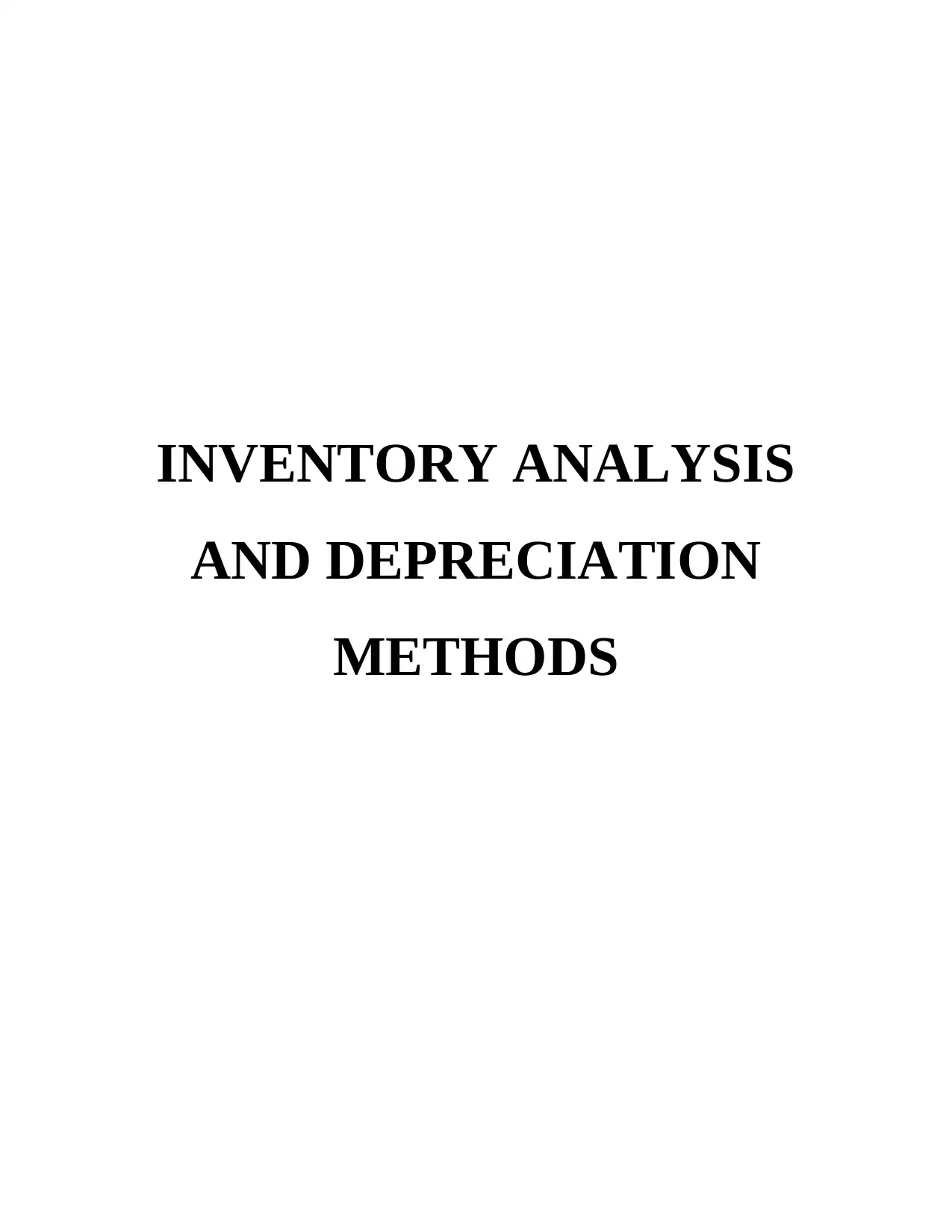
INVENTORY ANALYSIS
AND DEPRECIATION
METHODS
AND DEPRECIATION
METHODS
Paraphrase This Document
Need a fresh take? Get an instant paraphrase of this document with our AI Paraphraser
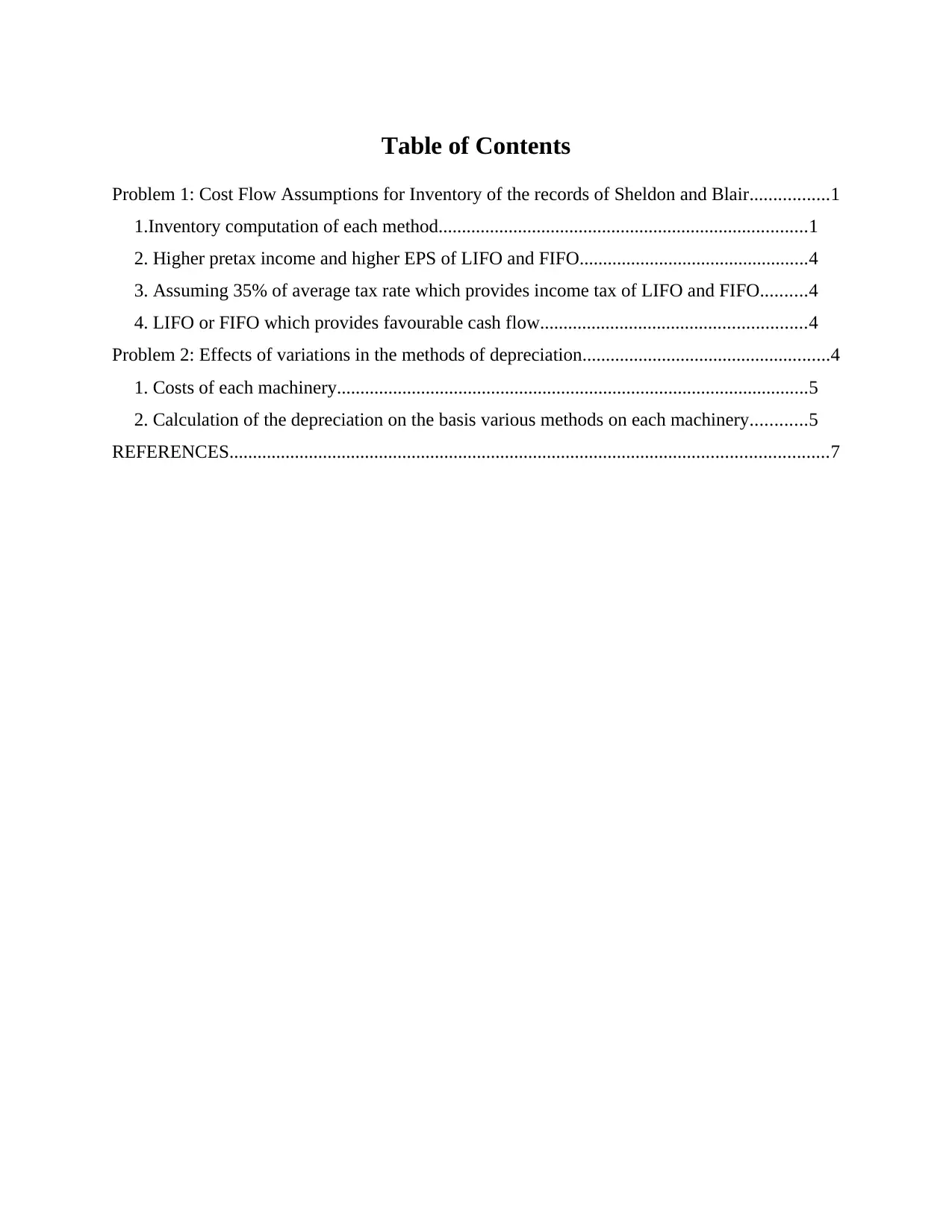
Table of Contents
Problem 1: Cost Flow Assumptions for Inventory of the records of Sheldon and Blair.................1
1.Inventory computation of each method...............................................................................1
2. Higher pretax income and higher EPS of LIFO and FIFO.................................................4
3. Assuming 35% of average tax rate which provides income tax of LIFO and FIFO..........4
4. LIFO or FIFO which provides favourable cash flow.........................................................4
Problem 2: Effects of variations in the methods of depreciation.....................................................4
1. Costs of each machinery.....................................................................................................5
2. Calculation of the depreciation on the basis various methods on each machinery............5
REFERENCES................................................................................................................................7
Problem 1: Cost Flow Assumptions for Inventory of the records of Sheldon and Blair.................1
1.Inventory computation of each method...............................................................................1
2. Higher pretax income and higher EPS of LIFO and FIFO.................................................4
3. Assuming 35% of average tax rate which provides income tax of LIFO and FIFO..........4
4. LIFO or FIFO which provides favourable cash flow.........................................................4
Problem 2: Effects of variations in the methods of depreciation.....................................................4
1. Costs of each machinery.....................................................................................................5
2. Calculation of the depreciation on the basis various methods on each machinery............5
REFERENCES................................................................................................................................7
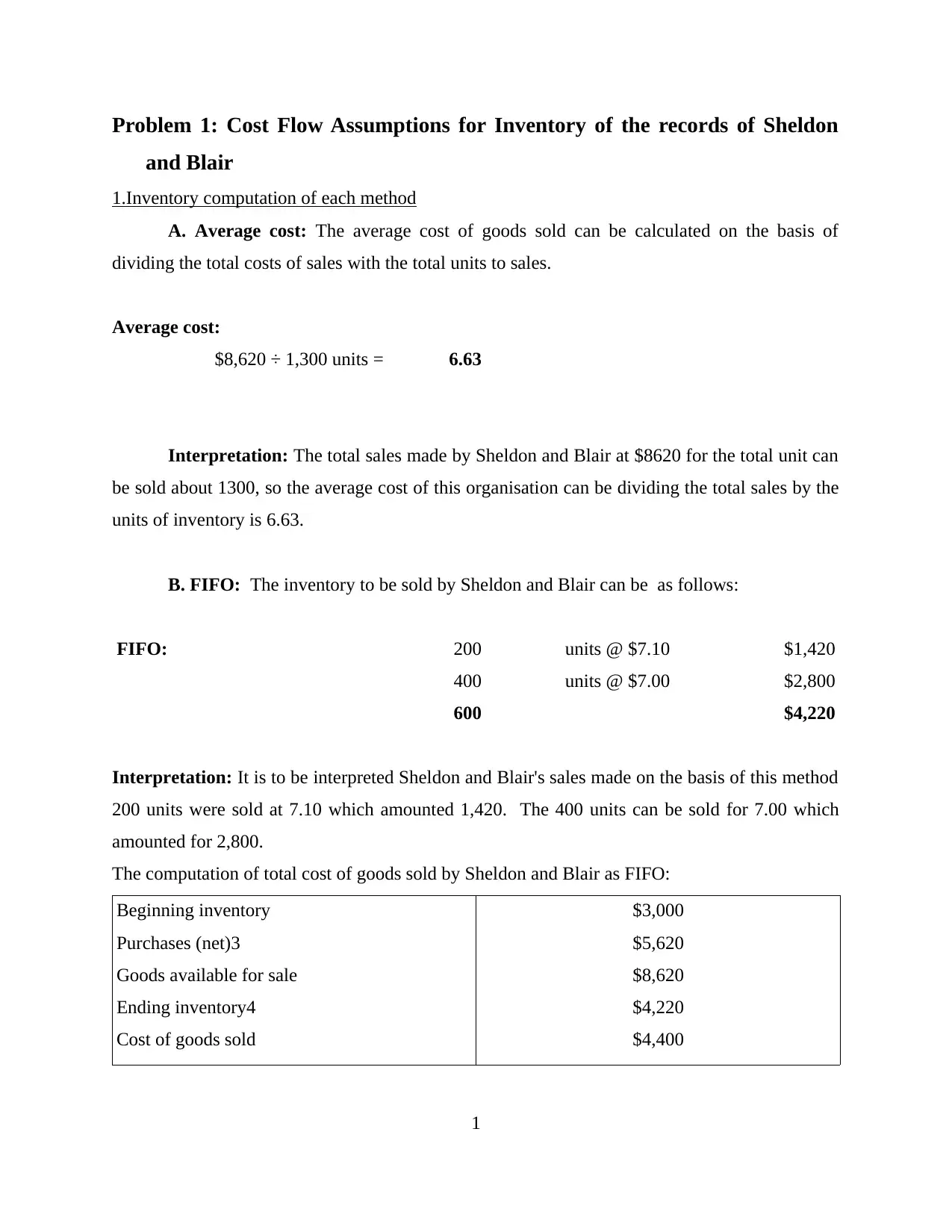
Problem 1: Cost Flow Assumptions for Inventory of the records of Sheldon
and Blair
1.Inventory computation of each method
A. Average cost: The average cost of goods sold can be calculated on the basis of
dividing the total costs of sales with the total units to sales.
Average cost:
$8,620 ÷ 1,300 units = 6.63
Interpretation: The total sales made by Sheldon and Blair at $8620 for the total unit can
be sold about 1300, so the average cost of this organisation can be dividing the total sales by the
units of inventory is 6.63.
B. FIFO: The inventory to be sold by Sheldon and Blair can be as follows:
FIFO: 200 units @ $7.10 $1,420
400 units @ $7.00 $2,800
600 $4,220
Interpretation: It is to be interpreted Sheldon and Blair's sales made on the basis of this method
200 units were sold at 7.10 which amounted 1,420. The 400 units can be sold for 7.00 which
amounted for 2,800.
The computation of total cost of goods sold by Sheldon and Blair as FIFO:
Beginning inventory
Purchases (net)3
Goods available for sale
Ending inventory4
Cost of goods sold
$3,000
$5,620
$8,620
$4,220
$4,400
1
and Blair
1.Inventory computation of each method
A. Average cost: The average cost of goods sold can be calculated on the basis of
dividing the total costs of sales with the total units to sales.
Average cost:
$8,620 ÷ 1,300 units = 6.63
Interpretation: The total sales made by Sheldon and Blair at $8620 for the total unit can
be sold about 1300, so the average cost of this organisation can be dividing the total sales by the
units of inventory is 6.63.
B. FIFO: The inventory to be sold by Sheldon and Blair can be as follows:
FIFO: 200 units @ $7.10 $1,420
400 units @ $7.00 $2,800
600 $4,220
Interpretation: It is to be interpreted Sheldon and Blair's sales made on the basis of this method
200 units were sold at 7.10 which amounted 1,420. The 400 units can be sold for 7.00 which
amounted for 2,800.
The computation of total cost of goods sold by Sheldon and Blair as FIFO:
Beginning inventory
Purchases (net)3
Goods available for sale
Ending inventory4
Cost of goods sold
$3,000
$5,620
$8,620
$4,220
$4,400
1
⊘ This is a preview!⊘
Do you want full access?
Subscribe today to unlock all pages.

Trusted by 1+ million students worldwide
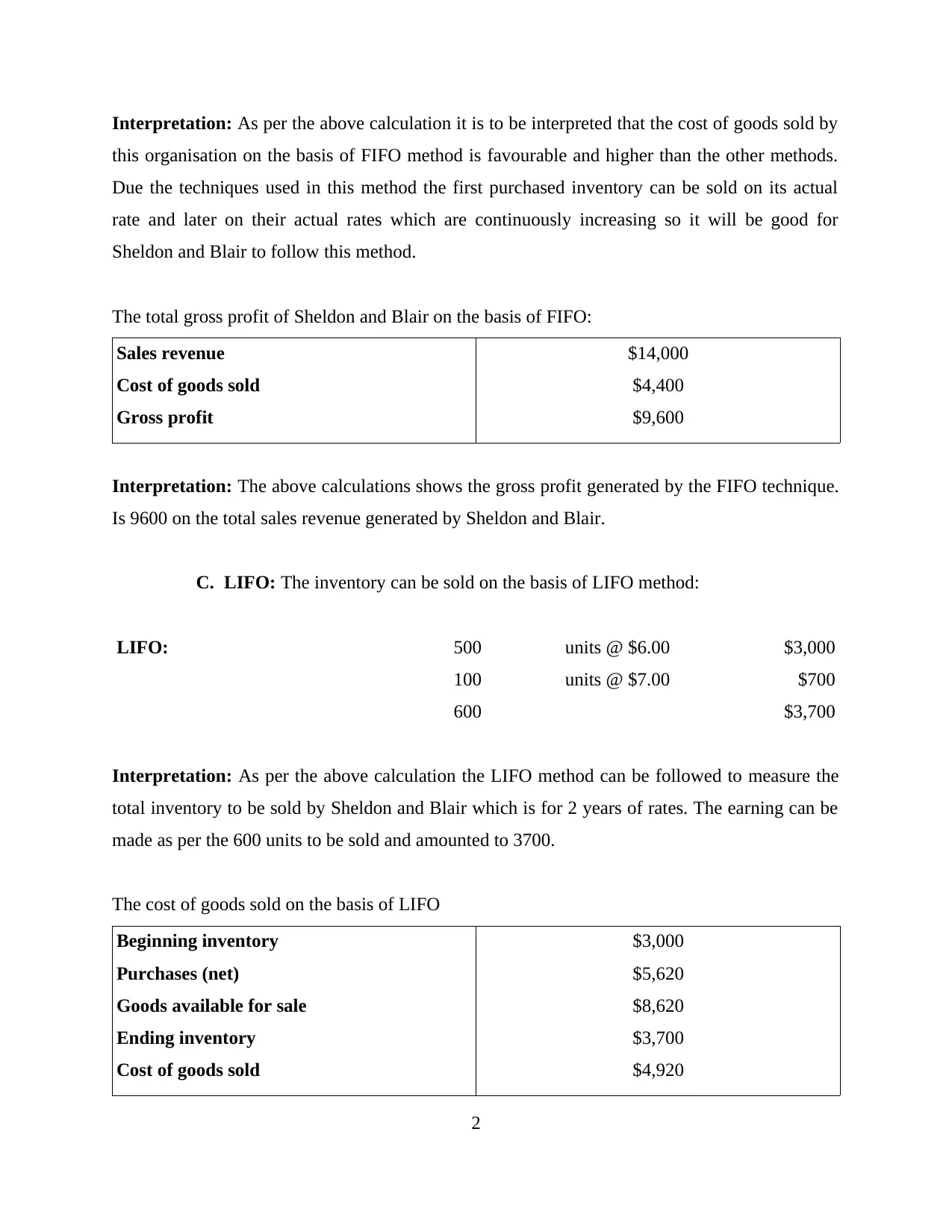
Interpretation: As per the above calculation it is to be interpreted that the cost of goods sold by
this organisation on the basis of FIFO method is favourable and higher than the other methods.
Due the techniques used in this method the first purchased inventory can be sold on its actual
rate and later on their actual rates which are continuously increasing so it will be good for
Sheldon and Blair to follow this method.
The total gross profit of Sheldon and Blair on the basis of FIFO:
Sales revenue
Cost of goods sold
Gross profit
$14,000
$4,400
$9,600
Interpretation: The above calculations shows the gross profit generated by the FIFO technique.
Is 9600 on the total sales revenue generated by Sheldon and Blair.
C. LIFO: The inventory can be sold on the basis of LIFO method:
LIFO: 500 units @ $6.00 $3,000
100 units @ $7.00 $700
600 $3,700
Interpretation: As per the above calculation the LIFO method can be followed to measure the
total inventory to be sold by Sheldon and Blair which is for 2 years of rates. The earning can be
made as per the 600 units to be sold and amounted to 3700.
The cost of goods sold on the basis of LIFO
Beginning inventory
Purchases (net)
Goods available for sale
Ending inventory
Cost of goods sold
$3,000
$5,620
$8,620
$3,700
$4,920
2
this organisation on the basis of FIFO method is favourable and higher than the other methods.
Due the techniques used in this method the first purchased inventory can be sold on its actual
rate and later on their actual rates which are continuously increasing so it will be good for
Sheldon and Blair to follow this method.
The total gross profit of Sheldon and Blair on the basis of FIFO:
Sales revenue
Cost of goods sold
Gross profit
$14,000
$4,400
$9,600
Interpretation: The above calculations shows the gross profit generated by the FIFO technique.
Is 9600 on the total sales revenue generated by Sheldon and Blair.
C. LIFO: The inventory can be sold on the basis of LIFO method:
LIFO: 500 units @ $6.00 $3,000
100 units @ $7.00 $700
600 $3,700
Interpretation: As per the above calculation the LIFO method can be followed to measure the
total inventory to be sold by Sheldon and Blair which is for 2 years of rates. The earning can be
made as per the 600 units to be sold and amounted to 3700.
The cost of goods sold on the basis of LIFO
Beginning inventory
Purchases (net)
Goods available for sale
Ending inventory
Cost of goods sold
$3,000
$5,620
$8,620
$3,700
$4,920
2
Paraphrase This Document
Need a fresh take? Get an instant paraphrase of this document with our AI Paraphraser
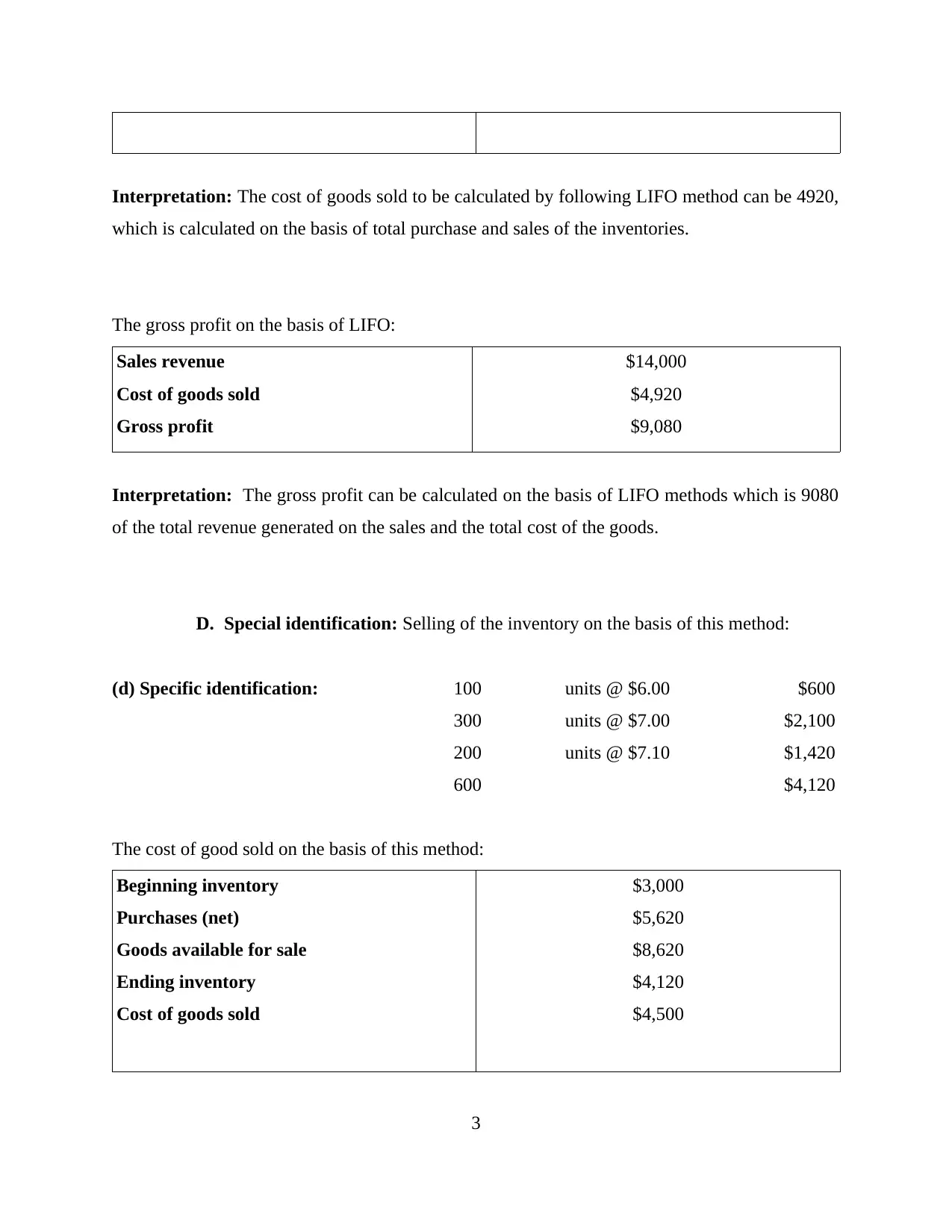
Interpretation: The cost of goods sold to be calculated by following LIFO method can be 4920,
which is calculated on the basis of total purchase and sales of the inventories.
The gross profit on the basis of LIFO:
Sales revenue
Cost of goods sold
Gross profit
$14,000
$4,920
$9,080
Interpretation: The gross profit can be calculated on the basis of LIFO methods which is 9080
of the total revenue generated on the sales and the total cost of the goods.
D. Special identification: Selling of the inventory on the basis of this method:
(d) Specific identification: 100 units @ $6.00 $600
300 units @ $7.00 $2,100
200 units @ $7.10 $1,420
600 $4,120
The cost of good sold on the basis of this method:
Beginning inventory
Purchases (net)
Goods available for sale
Ending inventory
Cost of goods sold
$3,000
$5,620
$8,620
$4,120
$4,500
3
which is calculated on the basis of total purchase and sales of the inventories.
The gross profit on the basis of LIFO:
Sales revenue
Cost of goods sold
Gross profit
$14,000
$4,920
$9,080
Interpretation: The gross profit can be calculated on the basis of LIFO methods which is 9080
of the total revenue generated on the sales and the total cost of the goods.
D. Special identification: Selling of the inventory on the basis of this method:
(d) Specific identification: 100 units @ $6.00 $600
300 units @ $7.00 $2,100
200 units @ $7.10 $1,420
600 $4,120
The cost of good sold on the basis of this method:
Beginning inventory
Purchases (net)
Goods available for sale
Ending inventory
Cost of goods sold
$3,000
$5,620
$8,620
$4,120
$4,500
3
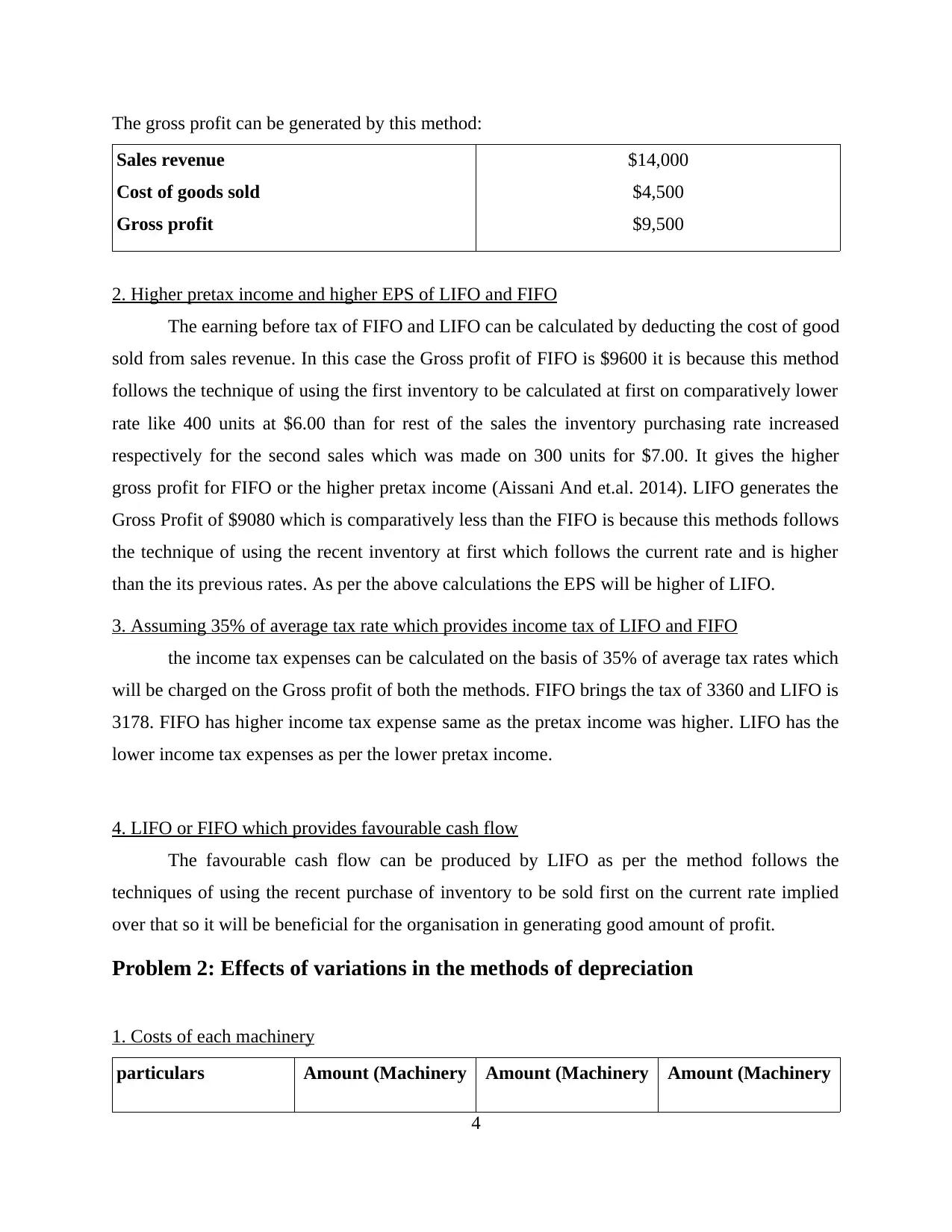
The gross profit can be generated by this method:
Sales revenue
Cost of goods sold
Gross profit
$14,000
$4,500
$9,500
2. Higher pretax income and higher EPS of LIFO and FIFO
The earning before tax of FIFO and LIFO can be calculated by deducting the cost of good
sold from sales revenue. In this case the Gross profit of FIFO is $9600 it is because this method
follows the technique of using the first inventory to be calculated at first on comparatively lower
rate like 400 units at $6.00 than for rest of the sales the inventory purchasing rate increased
respectively for the second sales which was made on 300 units for $7.00. It gives the higher
gross profit for FIFO or the higher pretax income (Aissani And et.al. 2014). LIFO generates the
Gross Profit of $9080 which is comparatively less than the FIFO is because this methods follows
the technique of using the recent inventory at first which follows the current rate and is higher
than the its previous rates. As per the above calculations the EPS will be higher of LIFO.
3. Assuming 35% of average tax rate which provides income tax of LIFO and FIFO
the income tax expenses can be calculated on the basis of 35% of average tax rates which
will be charged on the Gross profit of both the methods. FIFO brings the tax of 3360 and LIFO is
3178. FIFO has higher income tax expense same as the pretax income was higher. LIFO has the
lower income tax expenses as per the lower pretax income.
4. LIFO or FIFO which provides favourable cash flow
The favourable cash flow can be produced by LIFO as per the method follows the
techniques of using the recent purchase of inventory to be sold first on the current rate implied
over that so it will be beneficial for the organisation in generating good amount of profit.
Problem 2: Effects of variations in the methods of depreciation
1. Costs of each machinery
particulars Amount (Machinery Amount (Machinery Amount (Machinery
4
Sales revenue
Cost of goods sold
Gross profit
$14,000
$4,500
$9,500
2. Higher pretax income and higher EPS of LIFO and FIFO
The earning before tax of FIFO and LIFO can be calculated by deducting the cost of good
sold from sales revenue. In this case the Gross profit of FIFO is $9600 it is because this method
follows the technique of using the first inventory to be calculated at first on comparatively lower
rate like 400 units at $6.00 than for rest of the sales the inventory purchasing rate increased
respectively for the second sales which was made on 300 units for $7.00. It gives the higher
gross profit for FIFO or the higher pretax income (Aissani And et.al. 2014). LIFO generates the
Gross Profit of $9080 which is comparatively less than the FIFO is because this methods follows
the technique of using the recent inventory at first which follows the current rate and is higher
than the its previous rates. As per the above calculations the EPS will be higher of LIFO.
3. Assuming 35% of average tax rate which provides income tax of LIFO and FIFO
the income tax expenses can be calculated on the basis of 35% of average tax rates which
will be charged on the Gross profit of both the methods. FIFO brings the tax of 3360 and LIFO is
3178. FIFO has higher income tax expense same as the pretax income was higher. LIFO has the
lower income tax expenses as per the lower pretax income.
4. LIFO or FIFO which provides favourable cash flow
The favourable cash flow can be produced by LIFO as per the method follows the
techniques of using the recent purchase of inventory to be sold first on the current rate implied
over that so it will be beneficial for the organisation in generating good amount of profit.
Problem 2: Effects of variations in the methods of depreciation
1. Costs of each machinery
particulars Amount (Machinery Amount (Machinery Amount (Machinery
4
⊘ This is a preview!⊘
Do you want full access?
Subscribe today to unlock all pages.

Trusted by 1+ million students worldwide
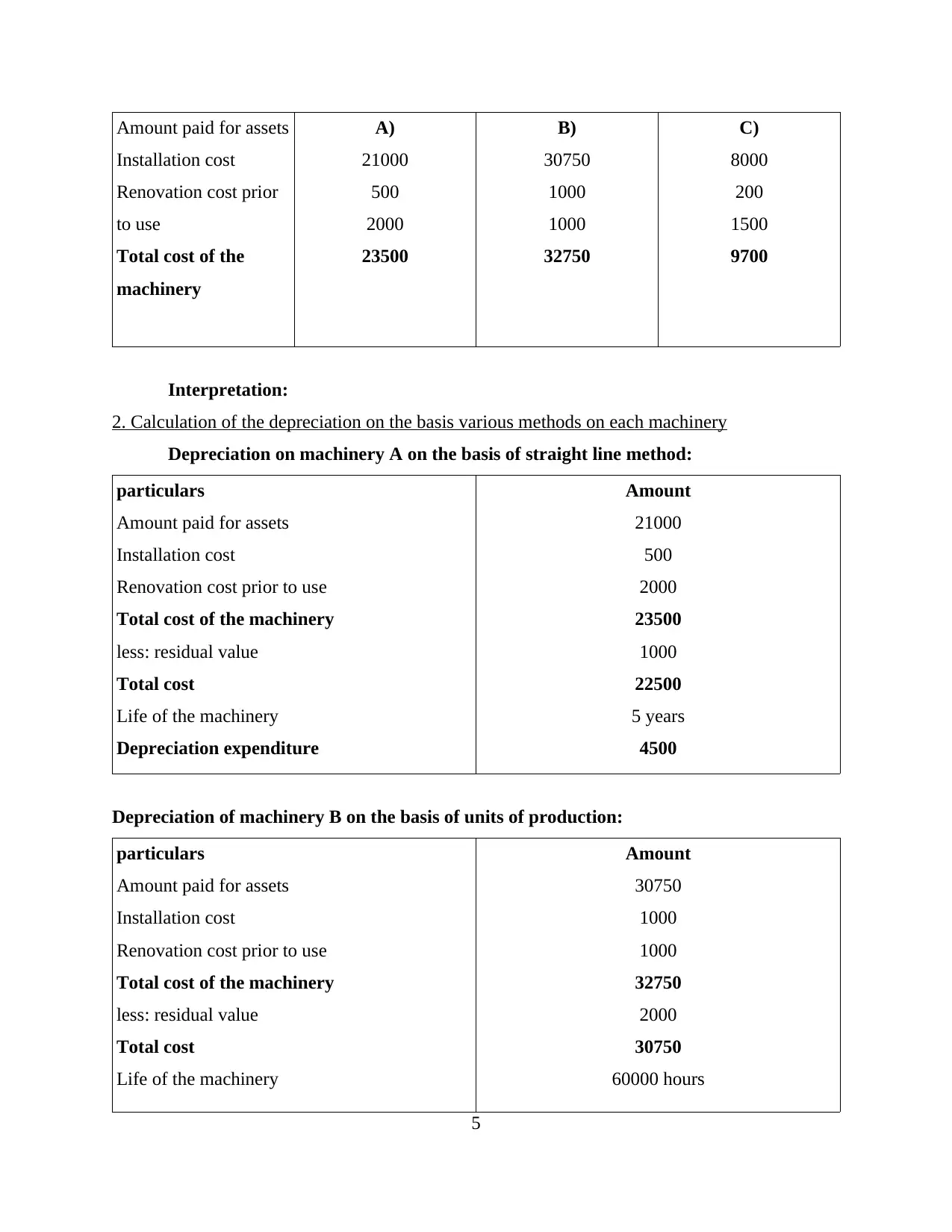
Amount paid for assets
Installation cost
Renovation cost prior
to use
Total cost of the
machinery
A)
21000
500
2000
23500
B)
30750
1000
1000
32750
C)
8000
200
1500
9700
Interpretation:
2. Calculation of the depreciation on the basis various methods on each machinery
Depreciation on machinery A on the basis of straight line method:
particulars
Amount paid for assets
Installation cost
Renovation cost prior to use
Total cost of the machinery
less: residual value
Total cost
Life of the machinery
Depreciation expenditure
Amount
21000
500
2000
23500
1000
22500
5 years
4500
Depreciation of machinery B on the basis of units of production:
particulars
Amount paid for assets
Installation cost
Renovation cost prior to use
Total cost of the machinery
less: residual value
Total cost
Life of the machinery
Amount
30750
1000
1000
32750
2000
30750
60000 hours
5
Installation cost
Renovation cost prior
to use
Total cost of the
machinery
A)
21000
500
2000
23500
B)
30750
1000
1000
32750
C)
8000
200
1500
9700
Interpretation:
2. Calculation of the depreciation on the basis various methods on each machinery
Depreciation on machinery A on the basis of straight line method:
particulars
Amount paid for assets
Installation cost
Renovation cost prior to use
Total cost of the machinery
less: residual value
Total cost
Life of the machinery
Depreciation expenditure
Amount
21000
500
2000
23500
1000
22500
5 years
4500
Depreciation of machinery B on the basis of units of production:
particulars
Amount paid for assets
Installation cost
Renovation cost prior to use
Total cost of the machinery
less: residual value
Total cost
Life of the machinery
Amount
30750
1000
1000
32750
2000
30750
60000 hours
5
Paraphrase This Document
Need a fresh take? Get an instant paraphrase of this document with our AI Paraphraser
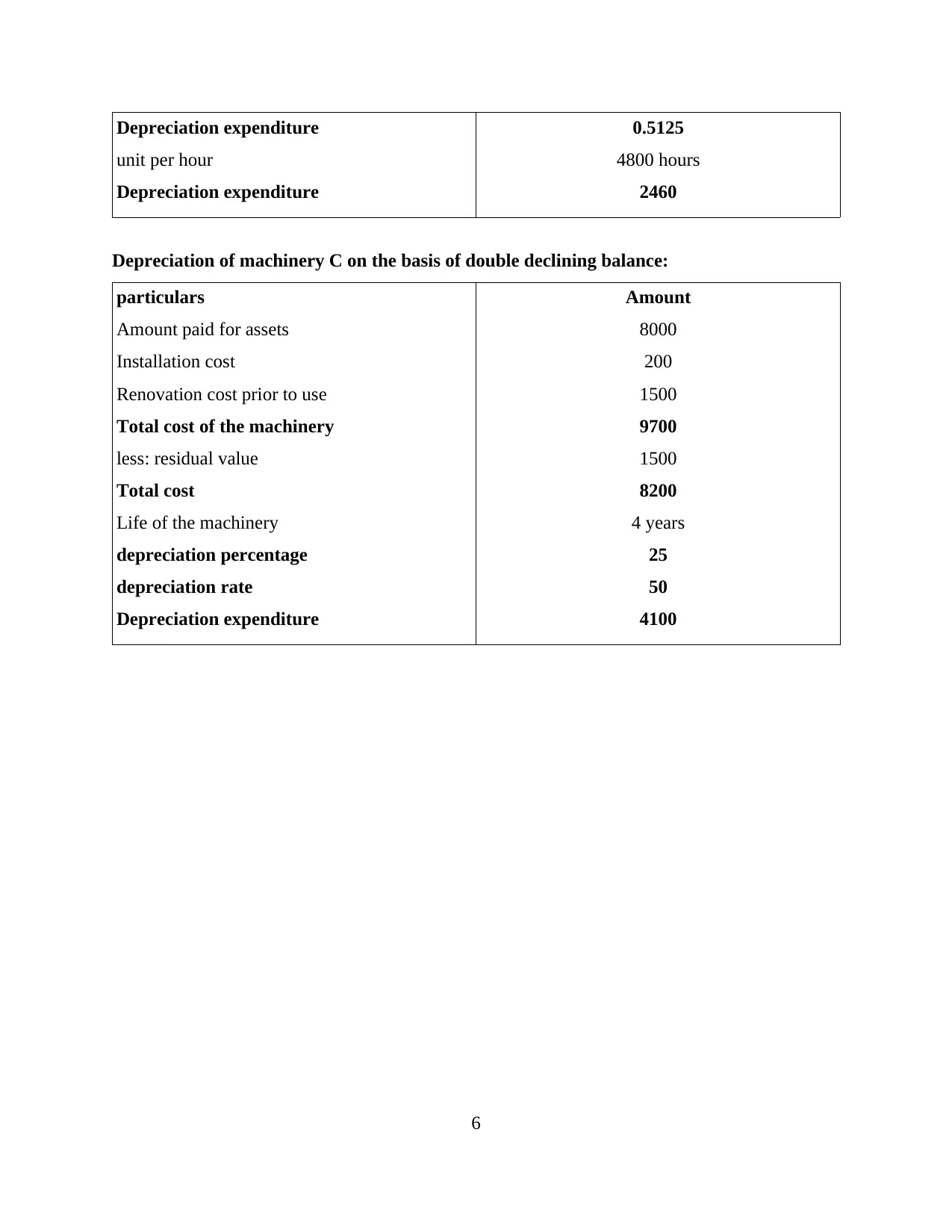
Depreciation expenditure
unit per hour
Depreciation expenditure
0.5125
4800 hours
2460
Depreciation of machinery C on the basis of double declining balance:
particulars
Amount paid for assets
Installation cost
Renovation cost prior to use
Total cost of the machinery
less: residual value
Total cost
Life of the machinery
depreciation percentage
depreciation rate
Depreciation expenditure
Amount
8000
200
1500
9700
1500
8200
4 years
25
50
4100
6
unit per hour
Depreciation expenditure
0.5125
4800 hours
2460
Depreciation of machinery C on the basis of double declining balance:
particulars
Amount paid for assets
Installation cost
Renovation cost prior to use
Total cost of the machinery
less: residual value
Total cost
Life of the machinery
depreciation percentage
depreciation rate
Depreciation expenditure
Amount
8000
200
1500
9700
1500
8200
4 years
25
50
4100
6
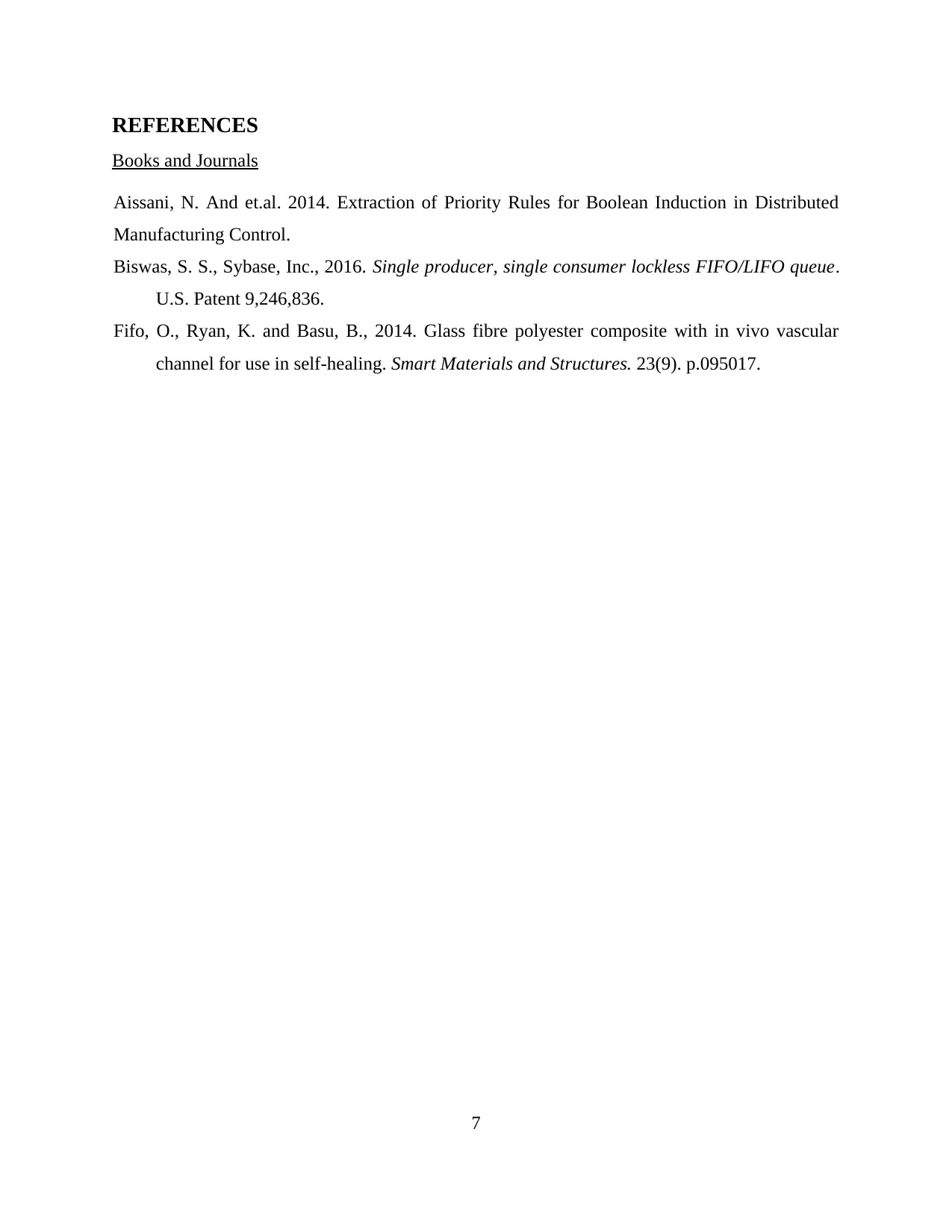
REFERENCES
Books and Journals
Aissani, N. And et.al. 2014. Extraction of Priority Rules for Boolean Induction in Distributed
Manufacturing Control.
Biswas, S. S., Sybase, Inc., 2016. Single producer, single consumer lockless FIFO/LIFO queue.
U.S. Patent 9,246,836.
Fifo, O., Ryan, K. and Basu, B., 2014. Glass fibre polyester composite with in vivo vascular
channel for use in self-healing. Smart Materials and Structures. 23(9). p.095017.
7
Books and Journals
Aissani, N. And et.al. 2014. Extraction of Priority Rules for Boolean Induction in Distributed
Manufacturing Control.
Biswas, S. S., Sybase, Inc., 2016. Single producer, single consumer lockless FIFO/LIFO queue.
U.S. Patent 9,246,836.
Fifo, O., Ryan, K. and Basu, B., 2014. Glass fibre polyester composite with in vivo vascular
channel for use in self-healing. Smart Materials and Structures. 23(9). p.095017.
7
⊘ This is a preview!⊘
Do you want full access?
Subscribe today to unlock all pages.

Trusted by 1+ million students worldwide
1 out of 9
Related Documents
Your All-in-One AI-Powered Toolkit for Academic Success.
+13062052269
info@desklib.com
Available 24*7 on WhatsApp / Email
![[object Object]](/_next/static/media/star-bottom.7253800d.svg)
Unlock your academic potential
Copyright © 2020–2025 A2Z Services. All Rights Reserved. Developed and managed by ZUCOL.





